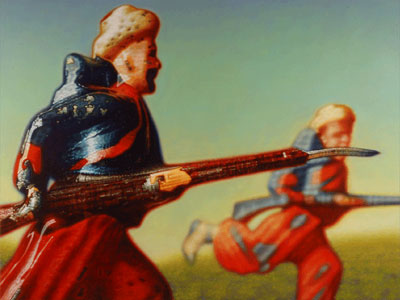 © Peter Drake HEADSetera Peter Drake, Laurence Hegarty, Mark Mennin Jack the Pelican presents "HEADSetera", an intimate show of heady interplay between three seasoned artists - Peter Drake, Laurence Hegarty and Mark Mennin - whose work couldn't be more different. Those who follow the goings on of the art world will no doubt recognize the names of one or another of these artists, as each is preeminently accomplished in his own arena. Unlikely, however, you will know all three. Their fans don't often mingle. We have here a Technicolor faux-colonialist painter, a mischievous semiotician of the playroom, and a postmodern disciple of Michelangelo Buonarroti. We've not chosen them to support a theme, nothing so literal as that. What excites is their thoughtful and unexpected impress of one upon another. And how strangely they bop ! We are moved by their mutual exchange and respect , over the years, as soldiers in the trenches. Most famous in his niche is Mark Mennin, a stone carver of rare ambition, whose landscape interventions typically embrace a geologic scale, measured in years of carving and acres of ground. Here, he unveils a confounding new body of work - belly-scaled stones in porously veined travertine and polished marble that oddly conjoin hollowed volumes of little girl frock dresses and portentously bearded patriarchal heads. One rock, two images - ambiguously simultaneous, one on top of another, or perhaps in flux. The postmodern eye is not unaccustomed to seeing such things. Surrealist games, Dali's paranoiac-critical method, Picabia and Salle, the loading of surface with multiplicity - all very familiar. But not in stone! The material remains for us unproblematically symbolic of permanence and stability. Which is why these folk-lore dualities of man/girl seem so insistently peculiar. Mennin did his time in the quarries of Italy. He is fluent in the history of the craft and its inherent logic, which is to say he is alert to the necessity of respecting the stubborn idiosyncrasies of the stone. (In fact, he is quite keen on the more unpredictable "irregulars" the architects typically reject.) So fluid is his process, he is able to think through it pictorially. It is mind-boggling how he fleshes the stone into color by following its mineral flows. An expert he is, but in doubling up the image Mennin manifestly subverts this sacrosanct tradition of stone-carving. It began with the Neoplatonism of Michelangelo. One soul, one stone, and a process of liberating discovery. It ends with Mennin. A "juggler". And no term might better describe Laurence Hegarty. His preoccupations are all in the air. He's critic, filmmaker, artist, of course... and quintessentially clinical psychotherapist. It's one giant loop of enlightened activity. And so with his art - the elements march into play like a troupe of impish players looking for action. It's a strange objecthood. You can just imagine one or another of these on its own, feeling as lonely as a stuffed animal, or as silent. How Hegarty plays them together is what makes them what they are. How unexpected! ...or naughty? The whole is generously open-ended. And, in the reading, so up for grabs! Hegarty dissimulates his anticipation of the game's three-dimensionality. He understates his pieces. In startling contrast to Mennin, with his dramatic stones, Hegarty casts his pieces as lightweights. Each is as iconically distinct as a board game piece, rendered with unworried modesty and divested of overmuch ego. (Think Brit, pre-YBA.) But he pre-loads them - eight months pregnant with quintuplets of association and imminence. They look like you could - or they even want you to - pick them up and move them around with little effort, figure it all out for yourself, make it your own game. But, beg though they might, you fear that once you touch the art (or think about it), there is no end to it. If there's anything more massively tragic underneath, and indeed there probably is, it's something you have to get to. "Hint hint: Buy more than one". All the parameters of Peter Drake's paintings are, by contrast, tightly determined from the get go. We've zoomed in on little vintage toy soldiers - from his father's collection - so close our eyeballs breathe on them. But there is little we can do. The toys unresponsively perform their singular functions, as cast - charging with bayonets, firing off their Gatling gun, staring blankly ahead - always the same, battle after battle, through the decades. Always, such figures recall the original moment of their conception in the anachronistic celebration of gallant war and imperial glory; and generations of little boys who believe/d with oversized hearts in grand codes of personal honor. At face value, these are fat, seductive pictures, charged with the romance of war. Drake plays it, echoing his soldiers' resolutely triumphant postures with exotic, deeply emotionalized twilight skies. And we play along, embracing the robust martial pride of "The Man Who Would Be King". In "Pyramid", 2008 it is just their heads. (Drake broke them, or imagined he did.) Still, they are unblinking stalwarts - "Rule, Britannia!" to the bitter end. Our narcotic rapture endures for only so long, before we see Drake's masterfully warm and fuzzy sfumato haze for what it is - the image in decay, smelling sweetly of death. All one really has to do is look again, to realize it was there the whole time - signs of wear, mostly chipped paint; battle scars, material fatigue and breakdown. Exhibition: April 25 - May 25, 2008 Gallery hours: Fri-Mon 12 - 6pm Jack the Pelican Presents 487 Driggs Avenue USA-Brooklyn, NY 11211 Telephone +1 718 782 0183 Email info@jackthepelicanpresents.com www.jackthepelicanpresents.com |